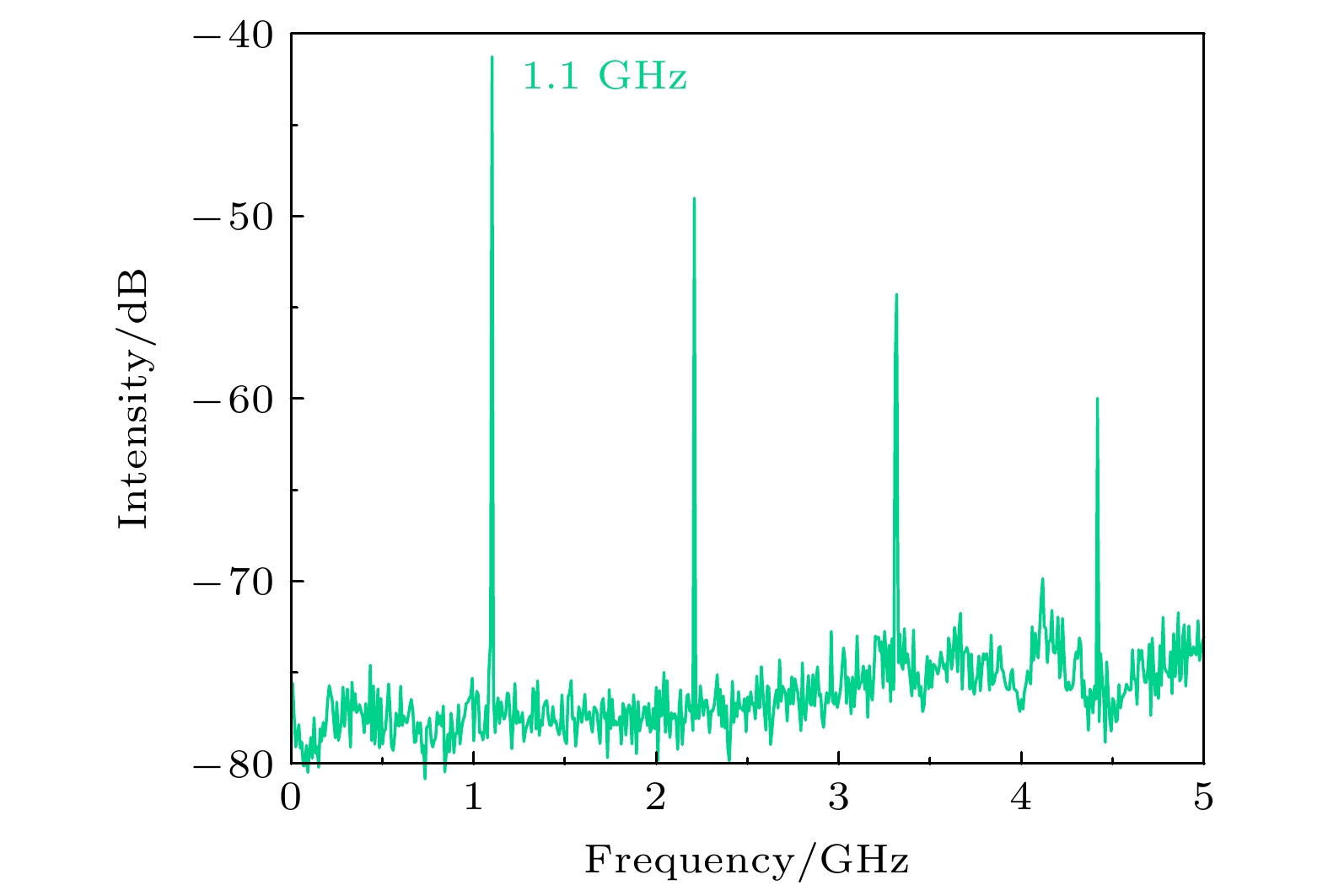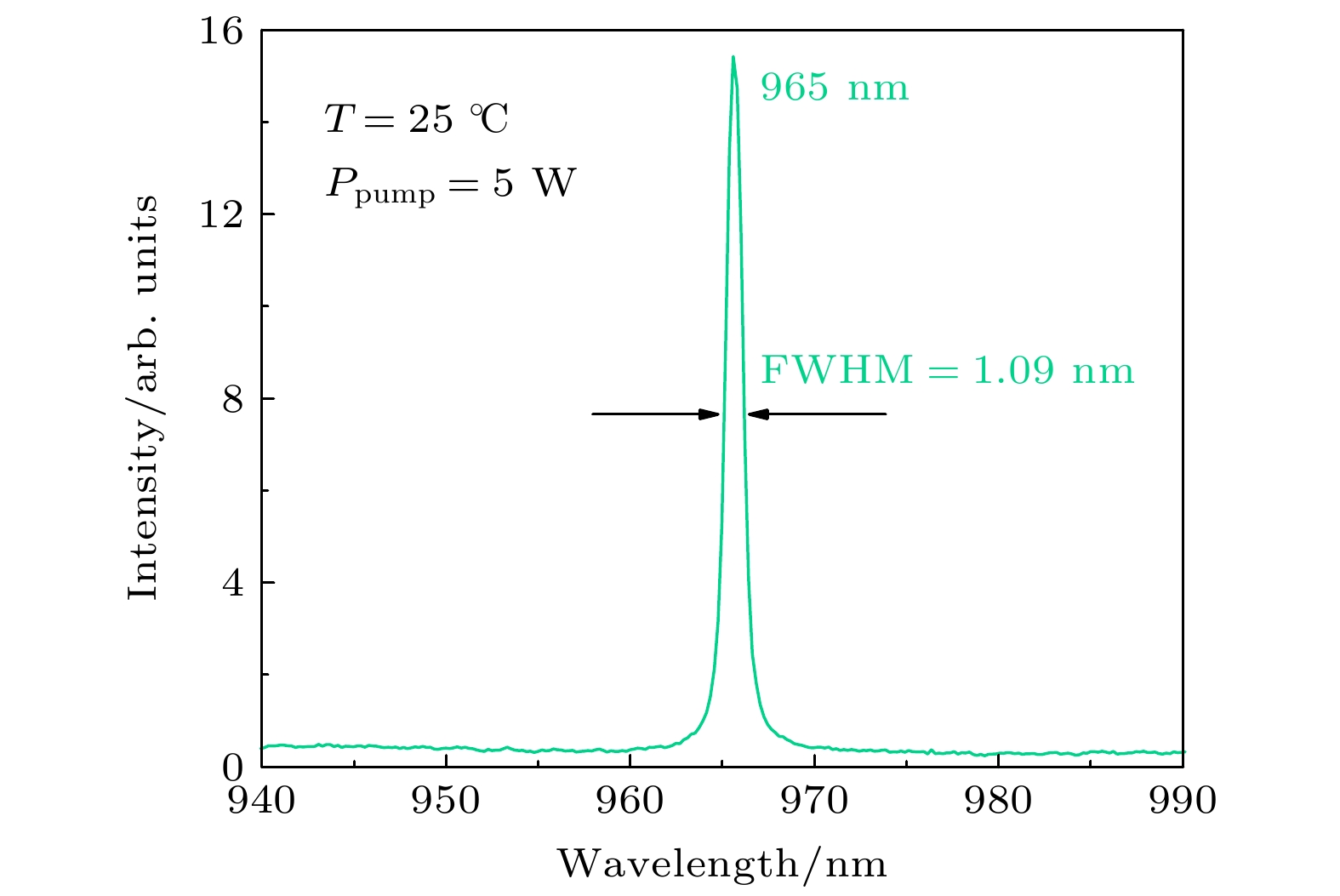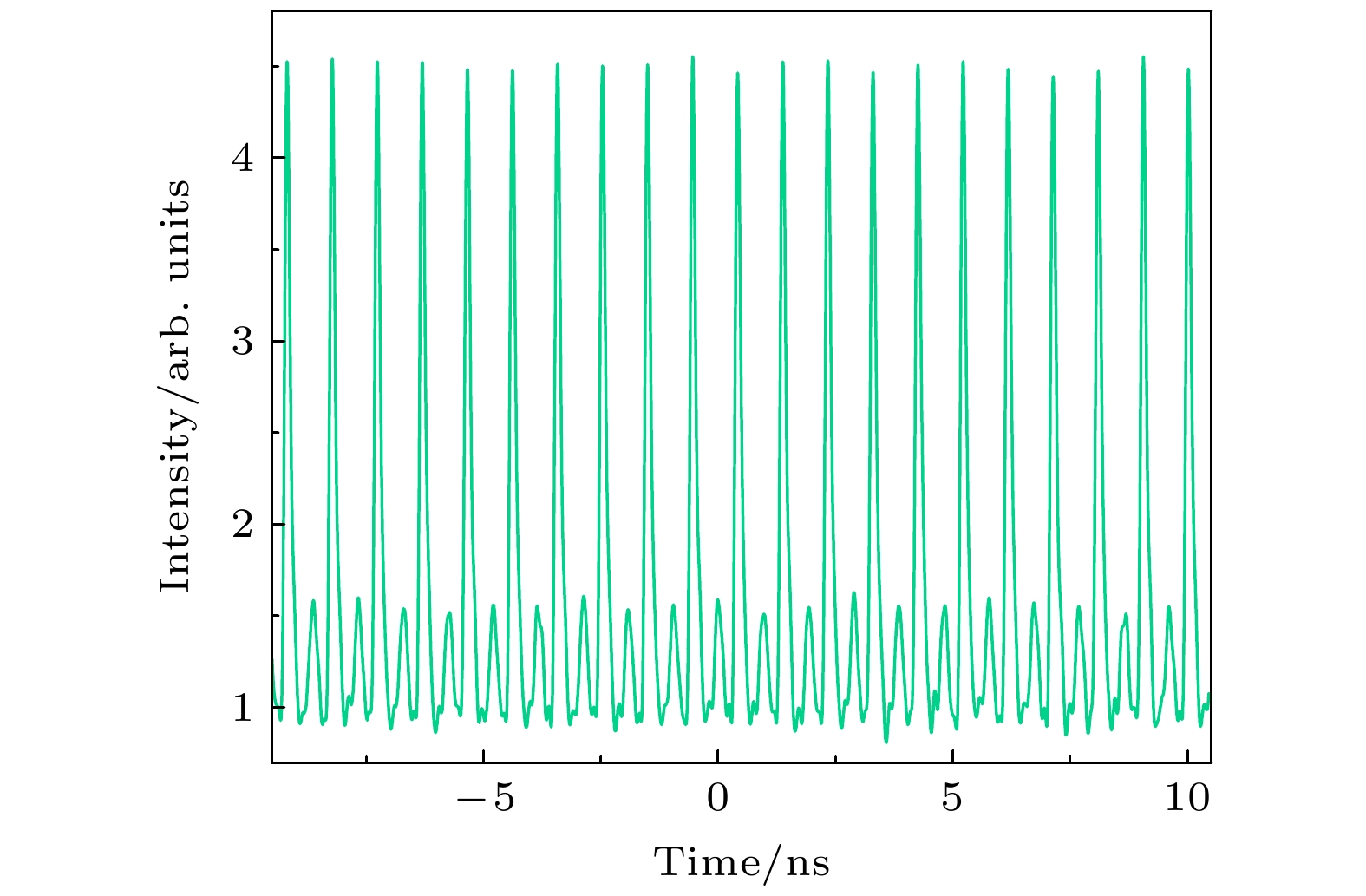-
双波长锁模激光器在光通信、泵浦探针实验、非线性频率变换等方面应用广泛. 本文报道了一种双波长自锁模半导体薄片激光器. 利用增益芯片底部的高反射率分布布拉格反射镜和外部的耦合输出镜构成简单的直线型谐振腔, 腔内不需要额外的插入元件, 依靠增益介质的克尔效应, 结合激光芯片上泵浦光斑形成的软光阑, 即可启动锁模过程, 实现稳定的自锁模输出. 锁模脉冲宽度为4.3 ps, 重复频率为1.1 GHz, 最大输出功率为323.9 mW. 在锁模的基础上, 使用简单的刀片作为波长调谐元件, 通过改变刀片插入谐振腔的深度, 可连续调谐激光波长, 并在某一特殊位置, 获得稳定等强度的双波长输出. 实验中的稳定等强度双波长为951和961 nm, 对应的输出功率为32 mW. 该双波长对应的差频辐射为3.3 THz, 具有较好的应用潜力.Dual-wavelength mode-locked lasers can be widely used in optical communication, pump-probe experiment, nonlinear frequency conversion, etc. In this paper, a dual-wavelength self-mode-locked semiconductor disk laser is reported for the first time, to the best of our knowledge. A simple linear resonator is formed by using a high reflectivity distributed Bragg reflector at the bottom of the gain chip, and an external output mirror; the cavity length is about 135 mm, with no need of additional inserted elements. Based on the Kerr effect of the gain medium and the soft aperture formed by the pump spot on the gain chip, along with the fine adjustment of cavity length and pump intensity, the mode-locking process can be started from the free running and the stable self-mode-locking can be realized. The mode-locked pulse width is 4.3 ps, the repetition rate is 1.1 GHz, and the maximum output power is 323.9 mW, which corresponds to a peak power of 68 W. After the laser is mode locked, a readily available blade, which can introduce a wavelength-dependent loss for different laser modes, resulting in a lager cavity loss for a longer-wavelength mode and a smaller cavity loss for a shorter-wavelength mode, is used as a wavelength tuning element, and is inserted into the cavity in the direction perpendicular to the optical axis of the resonator. By changing the depth of the blade inserted into the cavity, the laser wavelength can be continuously tuned from the initial oscillating wavelength (longer-wavelength) to a shorter wavelength, a stable dual-wavelength output with equal intensity can be obtained at a specific position, and the stable continuous-wave mode-locking can be maintained simultaneously. The steady dual-wavelengths in the experiment are 951 and 961 nm, and the corresponding output power is 32 mW. The above dual-wavelength outputs have good coherence since they are stimulated radiations from the same gain chip. Meanwhile, they have relatively high peak power and strictly meet the coaxial conditions, and these are all advantages for the difference frequency generation (DFG). The frequency of the DFG in the experiment is approximately 3.3 THz, which can be widely used in laser radar, remote sensing, homeland security, counter-terrorism, atmospheric and environmental monitoring and otherareas.
-
Keywords:
- dual-wavelength /
- self-mode-locking /
- semiconductor disk lasers /
- Kerr effect
[1] Guina M, Rantamäki A, Härkönen A 2017 J. Phys. D: Appl. Phys. 50 383001
 Google Scholar
Google Scholar
[2] Rahimi-Iman A 2016 J. Opt.-UK. 18 093003
 Google Scholar
Google Scholar
[3] Calvez S, Hastie J E, Guina M, Okhotnikov O G, Dawson M. D 2009 Laser Photonics Rev. 3 407
 Google Scholar
Google Scholar
[4] Esposito E, Keatings S, Gardner K, Harris J, Riis E, McConnell G 2008 Rev. Sci. Instrum. 79 083702
 Google Scholar
Google Scholar
[5] Wang C L, Chuang Y H, Pan C L 1995 Opt. Lett. 20 1071
 Google Scholar
Google Scholar
[6] Khalighi M A, Uysal M 2014 IEEE Commun. Surv. Tutorials 16 2231
 Google Scholar
Google Scholar
[7] Chen Y F, Tsai S W, Wang S C, Huang Y C, Lin T C, Wong B C 2002 Opt. Lett. 27 1809
 Google Scholar
Google Scholar
[8] Leinonen T, Morozov Y A, Harkonen A, Pessa M 2005 IEEE Photonics Technol. Lett. 17 2508
 Google Scholar
Google Scholar
[9] Fan L, Fallahi M, Hader J, Zakharian A R, Moloney J V, Stolz W, Koch S W, Bedford R, Murray J T 2007 Appl. Phys. Lett. 90 181124
 Google Scholar
Google Scholar
[10] Hessenius C, Terry N, Fallahi M, Moloney J, Bedford R 2010 Opt. Lett. 35 3060
 Google Scholar
Google Scholar
[11] Hessenius C, Lukowski M, Fallahi M 2012 Appl. Phys. Lett. 101 121110
 Google Scholar
Google Scholar
[12] Scheller M, Koch S W, Moloney J V 2012 Opt. Lett. 37 25
 Google Scholar
Google Scholar
[13] Zhang F, Gaafar M, Möller C, Stolz W, Koch M, Rahimi-Iman A 2016 IEEE Photonics Technol. Lett. 28 927
 Google Scholar
Google Scholar
[14] 邱小浪, 王爽爽, 张晓健, 朱仁江, 张鹏, 郭于鹤洋, 宋晏蓉 2019 物理学报 68 114204
 Google Scholar
Google Scholar
Qiu X L, Wang S S, Zhang X J, Zhu R J, Zhang P, Guo Y H Y, Song Y R 2019 Acta Phys. Sin. 68 114204
 Google Scholar
Google Scholar
[15] Zhang P, Mao L, Zhang X, Wang T, Wang L, Zhu R 2021 Opt. Express 29 16572
 Google Scholar
Google Scholar
[16] Scheller M, Baker C W, Koch S W, Moloney J V, Jones R J 2017 IEEE Photonics Technol. Lett. 29 790
 Google Scholar
Google Scholar
[17] De S, Baili G, Alouini M, Harmand J C, Bouchoule S, Bretenaker F 2014 Opt. Lett. 39 5586
 Google Scholar
Google Scholar
[18] Tilma B W, Mangold M, Zaugg C A, Link S M, Waldburger D, Klenner A, Mayer A S, Gini E, Golling M, Keller U 2015 Light-Sci. Appl. 4 e310
 Google Scholar
Google Scholar
[19] Good J T, Holland D B, Finneran I A, Carroll P B, Kelley M J, Blake G A 2015 Rev. Sci. Instrum. 86 103107
 Google Scholar
Google Scholar
[20] Miller D A B 2000 IEEE J. Sel. Top. Quantum Electron. 6 1312
 Google Scholar
Google Scholar
[21] Keller U 2003 Nature 424 831
 Google Scholar
Google Scholar
[22] Liu X, Yao X, Cui Y 2018 Phys. Rev. Lett. 121 023905
 Google Scholar
Google Scholar
[23] Liu X, Pang M 2019 Laser Photonics Rev. 13 1800333
 Google Scholar
Google Scholar
[24] Hoogland S, Dhanjal S, Tropper A C, Roberts J S, Haring R, Paschotta R, Morier-Genoud F, Keller U 2000 IEEE Photonics Technol. Lett. 12 1135
 Google Scholar
Google Scholar
[25] Gaafar M A, Rahimi-Iman A, Fedorova K A, Stolz W, Rafailov E U, Koch M 2016 Adv. Opt. Photonics 8 370
 Google Scholar
Google Scholar
[26] Chen Y F, Lee Y C, Liang H C, Lin K Y, Su K W, Huang K F 2011 Opt. Lett. 36 4581
 Google Scholar
Google Scholar
[27] Kornaszewski L, Maker G, Malcolm G P A, Butkus M, Rafailov E U, Hamilton C J 2012 Laser Photonics Rev. 6 L20
 Google Scholar
Google Scholar
[28] Bek R, Großmann M, Kahle H, Koch M, Rahimi-Iman A, Jetter M, Michler P 2017 Appl. Phys. Lett. 111 182105
 Google Scholar
Google Scholar
[29] Albrecht A R, Wang Y, Ghasemkhani M, Seletskiy D V, Cederberg J G, Sheik-Bahae M 2013 Opt. Express 21 28801
 Google Scholar
Google Scholar
[30] Cong Z, Tang D, De Tan W, Zhang J, Xu C, Luo D, Xu X, Li D, Xu J, Zhang X, Wang Q 2011 Opt. Express 19 3984
 Google Scholar
Google Scholar
[31] Scheller M, Baker C W, Koch S W, Moloney J V 2016 IEEE Photonics Technol. Lett. 28 1325
 Google Scholar
Google Scholar
-
图 3 锁模脉冲的射频频谱, 其中1.1 GHz的基频信号即为脉冲的重复频率, 该值与自锁模SDLs的135 mm谐振腔长度严格对应
Fig. 3. The RF spectrum of mode-locked pulse train, in which the fundamental frequency signal of 1.1 GHz is the repetition frequency of the mode-locked pulses, which strictly corresponds to the 135 mm resonator cavity length of the self-mode-locked SDLs.
-
[1] Guina M, Rantamäki A, Härkönen A 2017 J. Phys. D: Appl. Phys. 50 383001
 Google Scholar
Google Scholar
[2] Rahimi-Iman A 2016 J. Opt.-UK. 18 093003
 Google Scholar
Google Scholar
[3] Calvez S, Hastie J E, Guina M, Okhotnikov O G, Dawson M. D 2009 Laser Photonics Rev. 3 407
 Google Scholar
Google Scholar
[4] Esposito E, Keatings S, Gardner K, Harris J, Riis E, McConnell G 2008 Rev. Sci. Instrum. 79 083702
 Google Scholar
Google Scholar
[5] Wang C L, Chuang Y H, Pan C L 1995 Opt. Lett. 20 1071
 Google Scholar
Google Scholar
[6] Khalighi M A, Uysal M 2014 IEEE Commun. Surv. Tutorials 16 2231
 Google Scholar
Google Scholar
[7] Chen Y F, Tsai S W, Wang S C, Huang Y C, Lin T C, Wong B C 2002 Opt. Lett. 27 1809
 Google Scholar
Google Scholar
[8] Leinonen T, Morozov Y A, Harkonen A, Pessa M 2005 IEEE Photonics Technol. Lett. 17 2508
 Google Scholar
Google Scholar
[9] Fan L, Fallahi M, Hader J, Zakharian A R, Moloney J V, Stolz W, Koch S W, Bedford R, Murray J T 2007 Appl. Phys. Lett. 90 181124
 Google Scholar
Google Scholar
[10] Hessenius C, Terry N, Fallahi M, Moloney J, Bedford R 2010 Opt. Lett. 35 3060
 Google Scholar
Google Scholar
[11] Hessenius C, Lukowski M, Fallahi M 2012 Appl. Phys. Lett. 101 121110
 Google Scholar
Google Scholar
[12] Scheller M, Koch S W, Moloney J V 2012 Opt. Lett. 37 25
 Google Scholar
Google Scholar
[13] Zhang F, Gaafar M, Möller C, Stolz W, Koch M, Rahimi-Iman A 2016 IEEE Photonics Technol. Lett. 28 927
 Google Scholar
Google Scholar
[14] 邱小浪, 王爽爽, 张晓健, 朱仁江, 张鹏, 郭于鹤洋, 宋晏蓉 2019 物理学报 68 114204
 Google Scholar
Google Scholar
Qiu X L, Wang S S, Zhang X J, Zhu R J, Zhang P, Guo Y H Y, Song Y R 2019 Acta Phys. Sin. 68 114204
 Google Scholar
Google Scholar
[15] Zhang P, Mao L, Zhang X, Wang T, Wang L, Zhu R 2021 Opt. Express 29 16572
 Google Scholar
Google Scholar
[16] Scheller M, Baker C W, Koch S W, Moloney J V, Jones R J 2017 IEEE Photonics Technol. Lett. 29 790
 Google Scholar
Google Scholar
[17] De S, Baili G, Alouini M, Harmand J C, Bouchoule S, Bretenaker F 2014 Opt. Lett. 39 5586
 Google Scholar
Google Scholar
[18] Tilma B W, Mangold M, Zaugg C A, Link S M, Waldburger D, Klenner A, Mayer A S, Gini E, Golling M, Keller U 2015 Light-Sci. Appl. 4 e310
 Google Scholar
Google Scholar
[19] Good J T, Holland D B, Finneran I A, Carroll P B, Kelley M J, Blake G A 2015 Rev. Sci. Instrum. 86 103107
 Google Scholar
Google Scholar
[20] Miller D A B 2000 IEEE J. Sel. Top. Quantum Electron. 6 1312
 Google Scholar
Google Scholar
[21] Keller U 2003 Nature 424 831
 Google Scholar
Google Scholar
[22] Liu X, Yao X, Cui Y 2018 Phys. Rev. Lett. 121 023905
 Google Scholar
Google Scholar
[23] Liu X, Pang M 2019 Laser Photonics Rev. 13 1800333
 Google Scholar
Google Scholar
[24] Hoogland S, Dhanjal S, Tropper A C, Roberts J S, Haring R, Paschotta R, Morier-Genoud F, Keller U 2000 IEEE Photonics Technol. Lett. 12 1135
 Google Scholar
Google Scholar
[25] Gaafar M A, Rahimi-Iman A, Fedorova K A, Stolz W, Rafailov E U, Koch M 2016 Adv. Opt. Photonics 8 370
 Google Scholar
Google Scholar
[26] Chen Y F, Lee Y C, Liang H C, Lin K Y, Su K W, Huang K F 2011 Opt. Lett. 36 4581
 Google Scholar
Google Scholar
[27] Kornaszewski L, Maker G, Malcolm G P A, Butkus M, Rafailov E U, Hamilton C J 2012 Laser Photonics Rev. 6 L20
 Google Scholar
Google Scholar
[28] Bek R, Großmann M, Kahle H, Koch M, Rahimi-Iman A, Jetter M, Michler P 2017 Appl. Phys. Lett. 111 182105
 Google Scholar
Google Scholar
[29] Albrecht A R, Wang Y, Ghasemkhani M, Seletskiy D V, Cederberg J G, Sheik-Bahae M 2013 Opt. Express 21 28801
 Google Scholar
Google Scholar
[30] Cong Z, Tang D, De Tan W, Zhang J, Xu C, Luo D, Xu X, Li D, Xu J, Zhang X, Wang Q 2011 Opt. Express 19 3984
 Google Scholar
Google Scholar
[31] Scheller M, Baker C W, Koch S W, Moloney J V 2016 IEEE Photonics Technol. Lett. 28 1325
 Google Scholar
Google Scholar
计量
- 文章访问数: 8811
- PDF下载量: 136
- 被引次数: 0














 下载:
下载:










